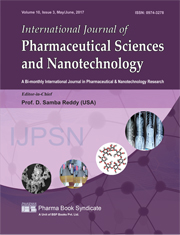Fabrication of Triamcinolone Acetonide Cream and Ointment: Optimization, Evaluation and Pharmacodynamic Assessments
DOI:
https://doi.org/10.37285/ijpsn.2017.10.3.4Abstract
The present investigation describes the optimization and evaluation of topical triamcinolone acetonide (TA) cream and ointment along with their sensory test on healthy human volunteers. TA cream and ointment were prepared by fusion followed by high-speed homogenization technique. The prepared creams and ointments were subjected to evaluation for physical parameters like pH, Fourier transform infrared spectroscopy, viscosity, assay, drug content, in vitro diffusion studies and accelerated stability study. Further, sensory test was performed with 30 healthy human volunteers. Based on physicochemical characterizations, we found that batch FC6 was the optimized batch for TA cream and batch F3 was the optimized batch for TA ointment formulations. Results of both the optimized formulations showed favorable viscosity as compared to reference drug (Fougera). In vitro diffusion study demonstrated increased drug release with optimized batch of both cream and ointment. The optimized TA cream and ointment showed good stability when storage at accelerated conditions for three months. Finally, sensory test results indicated ‘good feel’ when both optimized formulations applied on the human skin. In conclusion, TA cream and ointment offers great potential for topical drug delivery system in the treatment of anti-inflammatory disease, which reduces the inflammation of skin.
Downloads
Metrics
Keywords:
Triamcinolone Acetonide, viscosity, diffusion, stability, sensory testDownloads
Published
How to Cite
Issue
Section
References
Arunkumar A, Kalappanavar AN, Annigeri RG and Kalappa SG (2015). Relative efficacy of pimecrolimus cream and triamcinolone acetonide paste in the treatment of symptomatic oral lichen planus, Indian J Dent 6: 14-19.
Chaurasia S, Patel RR, Chaubey P, Kumar N, Khan G and Mishra B (2015). Lipopolysaccharide based oral nanocarriers for the improvement of bioavailability and anticancer efficacy of curcumin, Carbohyd Polym 130: 9-17.
Chaurasia S, Patel RR, Kumar N and Mishra B (2014). Optimization of parameters for the fabrication of curcumin loaded polymeric nanoparticles using taguchi robust design, Adv Sci Lett 20: 1028-1038.
da Silva AA Jr, de Matos JR, Formariz TP, Rossanezi G, Scarpa MV, do Egito ES and de Oliveira AG (2009). Thermal behavior and stability of biodegradable spray-dried microparticles containing triamcinolone, Int J Pharm 368: 45-55.
Ference JD and Last AR (2009). Choosing topical corticosteroids, Am Fam Phys 79: 135-140.
Franz TJ (1978). The finite dose technique as a valid in vitro model for the study of percutaneous absorption in man, Curr Prob Dermatol 7: 58.
Gasperlin M, Tusar L, Tusar M, Smid-Korbar J, Zupan J and Kristl J (1998). Viscosity prediction of lipophilic semisolid emulsion systems by neural network modeling, Int J Pharm 196: 37-50.
Higuchi WI (1962). Analysis of data on the medicament release from ointments, J Pharm Sci 51: 802-4.
Kumar N, Chaurasia S, Patel RR, Kumar V and Mishra B (2014). Development and Optimization of Atorvastatin Calcium Loaded Oral Biodegradable Polymeric Nanoparticles Using Central Composite Design, Adv Sci Lett 20: 984-993.
Lina E, Rene AW, Andries van der B, Jon FP, Anke MJ and Frits B (2005). Relating particles and texture perception, Physiol Behav 86: 111-117.
Low PA, Opfer-Gehrking TL, Dyck PJ, Litchy WJ and O'Brien PC (1995). Double-blind, placebo-controlled study of the application of capsaicin cream in chronic distal painful polyneuropathy, Pain 62:163-168.
Nallagundla S, Patnala S and Kanfer I (2014). Comparison of in vitro release rates of acyclovir from cream formulations using vertical diffusion cells. AAPS Pharm Sci Tech 15: 994-999.
Ogiso T, Hino T, Iwaki M and Tani T (1998). Drug penetration through living skin equivalent, rat and human skins, and effect of enhancer on penetration, J Pharm Sci Technol 58:155-163.
Pretsch E, Bühlmann P and Badertscher M (2009). IR Spectroscopy. Structure Determination of Organic Compounds. Springer, p 1, Berlin Heidelberg.
Thomas KS, Armstrong S, Avery A, Po AL, O'Neill C and Williams HC (2002). Randomised controlled trial of short bursts of a potent topical corticosteroid versus more prolonged use of a mild preparation, for children with mild or moderate atopic eczema, Br Med J 324: 768-771.
Thorgeirsd o´ ttir TO, Thormar H and Kristmundsd o´ ttir T (2006). Viscoelastic properties of a virucidal cream containing the monoglyceride monocaprin: Effects of formulation variables: A technical note, AAPS Pharm Sci Tech. 7, E95-E98.
Trottet L, Owen H, Holme P, Heylings J, Collin IP and Breen A (2005). Are all acyclovir cream formulations bioequivalent?, Int J Pharm 304: 63-71.
Wiedersberg S, Leopold CS and Guy RH (2008). Bioavailability and bioequivalence of topical glucocorticoids, Eur J Pharm Biopharm 68: 453-466.
Zhang JZ, Cavet ME, VanderMeid KR, Salvador-Silva M, López FJ and Ward KW (2009). BOL-303242-X, a novel selective glucocorticoid receptor agonist, with full anti-inflammatory properties in human ocular cells, Mol Vis 15: 2606-26016.






